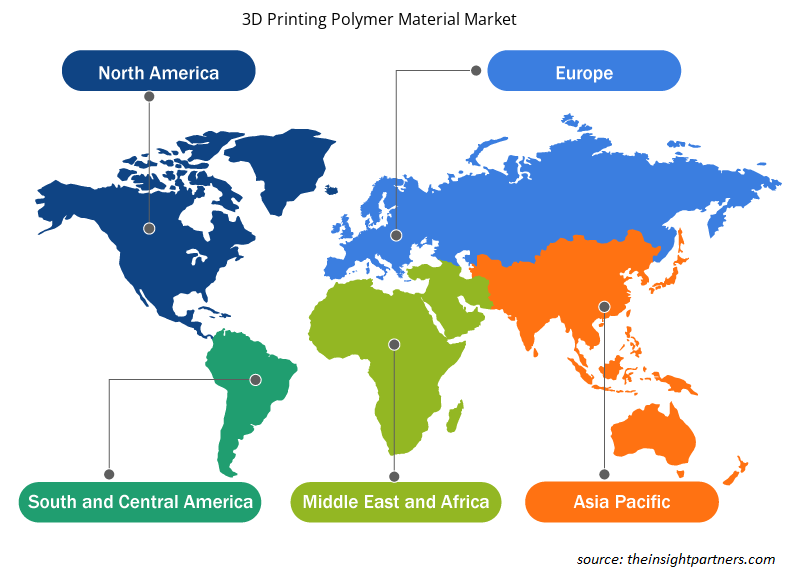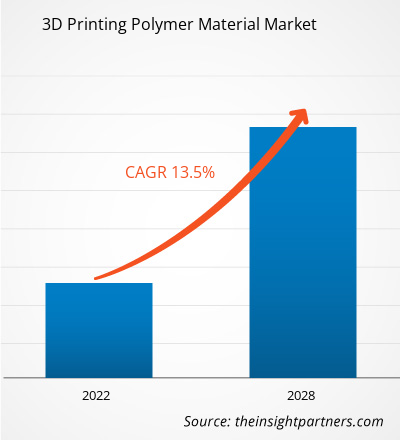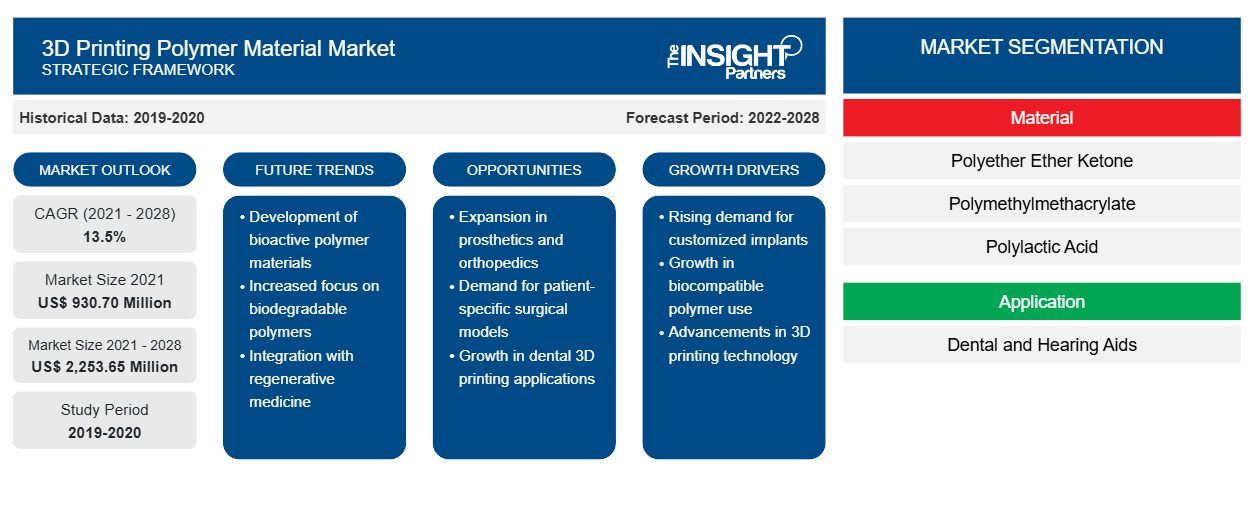Il mercato dei materiali polimerici per la stampa 3D per applicazioni mediche è stato valutato a 930,70 milioni di dollari nel 2021 e si prevede che raggiungerà i 2.253,65 milioni di dollari entro il 2028; si prevede una crescita a un CAGR del 13,5% dal 2021 al 2028.CAGR of 13.5% from 2021 to 2028.
I polimeri sono uno dei principali materiali per la stampa 3D. La stampa 3D polimerica è una tecnologia emergente che ha maggiori applicazioni nei settori, in particolare nel campo medico. Il materiale polimerico per la stampa 3D è costituito da polietere etere chetone, polimetilmetacrilato e acido polilattico. Uno dei principali motori della crescita del mercato dei materiali polimerici per la stampa 3D è un crescente utilizzo della stampa 3D in odontoiatria per varie applicazioni. In odontoiatria, l'uso della stampa 3D ha visto un rapido aumento. La tecnologia di stampa 3D è ampiamente utilizzata dai dentisti per sostituire o riparare un dente danneggiato, creare un modello ortodontico e produrre corone, capsule e protesi dentarie. Nel 2020, il Nord America deteneva la quota di fatturato maggiore del mercato globale dei materiali polimerici per la stampa 3D per applicazioni mediche . L'aumento dell'invecchiamento della popolazione e la crescente esposizione a rumori forti dovuti alla rapida urbanizzazione e industrializzazione nel Nord America stanno portando a un aumento della popolazione sorda. Ciò sta alimentando la domanda di apparecchi acustici e di conseguenza favorendo la crescita del mercato nordamericano dei materiali polimerici per stampa 3D per applicazioni mediche. Secondo il Survey of Income and Program Participation (SIPP), oltre 600.000 persone negli Stati Uniti sono sorde e circa 28 milioni di persone della popolazione del paese soffrono di sordità parziale. Quindi, la regione sta assistendo a una domanda di apparecchi acustici e sta offrendo opportunità redditizie ai produttori di materiali polimerici 3D per espandere la loro quota di mercato in Nord America.polyether ether ketone, polymethylmethacrylate, and polylactic acid. One of the major driver for the 3D printing polymer material market growth is an increasing use of 3D printing in dentistry for various applications. In dentistry, the use of 3D printing has seen a rapid increase. 3D printing technology is highly used by dentists to replace or repair a damaged tooth, create an orthodontic model, and produce crowns, caps, and dentures.
Personalizza questo report in base alle tue esigenze
Riceverai la personalizzazione gratuita di qualsiasi report, comprese parti di questo report, o analisi a livello nazionale, pacchetto dati Excel, oltre a usufruire di grandi offerte e sconti per start-up e università
-
Scopri le principali tendenze di mercato in questo rapporto.Questo campione GRATUITO includerà analisi di dati che spaziano dalle tendenze di mercato alle stime e alle previsioni.
Impatto della pandemia di COVID-19 sul mercato dei materiali polimerici per stampa 3D per applicazioni mediche
Prima della pandemia di COVID-19, il mercato dei materiali polimerici per stampa 3D per applicazioni mediche era in crescita a causa dell'elevata domanda di polimeri nella stampa 3D per realizzare diversi dispositivi medici, strumenti, impianti personalizzati e modelli medici. Tuttavia, nel 2020, vari settori hanno dovuto rallentare le loro operazioni a causa delle interruzioni nelle catene del valore causate dalla chiusura dei confini nazionali e internazionali. La pandemia di COVID-19 ha avuto un impatto negativo sulle economie e sulle industrie di vari paesi a causa di blocchi, divieti di viaggio e chiusure aziendali. La domanda di materiali polimerici per stampa 3D in applicazioni come impianti dentali, protesi dentarie, accessori per impianti, apparecchi acustici si è ridotta a causa della bassa domanda di questi prodotti. Tuttavia, la domanda di polimeri per stampa 3D è aumentata durante la pandemia di COVID-19 per la produzione di diversi dispositivi di protezione individuale e dispositivi medici. La stampa 3D di polimeri si è affermata come una tecnologia praticabile per produrre valvole di ventilazione, occhiali di sicurezza, visiere protettive e tamponi di prova durante la pandemia.lockdowns, travel bans, and business shutdowns. The demand for 3D printing polymer materials in application such as dental implants, dental prosthetics, implant accessories, hearing aids has reduced due to low demand for these products. However, the demand for 3D printing polymers have increased during the COVID-19 pandemic for the production of different personal protective equipment and medical devices.
Approfondimenti di mercato:
crescente utilizzo della stampa 3D in odontoiatria
In odontoiatria, l'uso della stampa 3D ha visto un rapido aumento. La stampa 3D offre vari vantaggi rispetto alle tecniche sottrattive/di fresatura. Consente la produzione di geometrie complesse con facilità e riduce lo spreco di materiale, che generalmente viene perso durante la fresatura. La stampa 3D consente di stampare più apparecchi contemporaneamente. Anche la precisione è migliorata con la stampa 3D. Le applicazioni della tecnologia di stampa 3D in odontoiatria sono ampie. Le malattie orali sono un grave onere sanitario per diversi paesi in tutto il mondo e colpiscono le persone per tutta la vita. Secondo il Global Burden of Disease 2017, la carie non curata nei denti permanenti è la condizione di salute più comune. La prevalenza delle malattie orali continua ad aumentare con l'aumento dell'urbanizzazione e il cambiamento delle condizioni di vita. Diversi prodotti dentali realizzati utilizzando la tecnologia di stampa 3D trovano ampie applicazioni nel restauro della struttura dentale. Quindi, l'elevata incidenza di carie dentali e altre malattie dentali porta a un crescente utilizzo di prodotti stampati in 3D in odontoiatria.subtractive/milling techniques. It allows the production of complex geometries with ease and reduces wastage of material, which is generally lost to milling. 3D printing allows for multiple appliances to be printed at once. Accuracy is also improved with 3D printing. Applications of
Approfondimenti sulle applicazioni
In base all'applicazione, il mercato globale dei materiali polimerici per stampa 3D per applicazioni mediche è segmentato in apparecchi odontoiatrici e acustici. Il segmento odontoiatrico ha detenuto una quota maggiore nel mercato dei materiali polimerici per stampa 3D per applicazioni mediche nel 2020. La crescita del mercato dei materiali polimerici per stampa 3D per applicazioni mediche per il segmento può essere attribuita all'elevata adozione di materiali polimerici per la progettazione di strutture di impalcature grazie alle loro proprietà biologiche e meccaniche migliorate, alla facilità di lavorazione, ai bassi costi di produzione e alle proprietà leggere rispetto a metalli e ceramiche.
Evonik Industries AG; STRATASYS LTD; Formlabs; Henkel AG & COMPANY, KGAA; Arkema; BASF SE; Roboze; Bionic Production GmbH; Orion Additive Manufacturing GmbH; e Solvay SA sono tra i player che operano nel mercato globale dei materiali polimerici per stampa 3D per applicazioni mediche. I player del mercato si concentrano sulla fornitura di prodotti di alta qualità per soddisfare la domanda dei clienti. Industries AG; STRATASYS LTD; Formlabs; Henkel AG & COMPANY, KGAA; Arkema; BASF SE; Roboze; Bionic Production GmbH; Orion Additive Manufacturing GmbH; and Solvay S.A. are among the players operating in the global 3D printing polymer material market for medical application. Market players focus on providing high quality products to meet the customer demand.
Approfondimenti regionali sul mercato dei materiali polimerici per la stampa 3D
Le tendenze regionali e i fattori che influenzano il mercato dei materiali polimerici per stampa 3D durante il periodo di previsione sono stati ampiamente spiegati dagli analisti di Insight Partners. Questa sezione discute anche i segmenti e la geografia del mercato dei materiali polimerici per stampa 3D in Nord America, Europa, Asia Pacifico, Medio Oriente e Africa e America meridionale e centrale.

- Ottieni i dati specifici regionali per il mercato dei materiali polimerici per stampa 3D
Ambito del rapporto di mercato sui materiali polimerici per stampa 3D
| Attributo del report | Dettagli |
|---|---|
| Dimensioni del mercato nel 2021 | 930,70 milioni di dollari USA |
| Dimensioni del mercato entro il 2028 | 2.253,65 milioni di dollari USA |
| CAGR globale (2021 - 2028) | 13,5% |
| Dati storici | 2019-2020 |
| Periodo di previsione | 2022-2028 |
| Segmenti coperti |
Per materiale
|
| Regioni e Paesi coperti |
America del Nord
|
| Leader di mercato e profili aziendali chiave |
|
Densità dei player del mercato dei materiali polimerici per la stampa 3D: comprendere il suo impatto sulle dinamiche aziendali
Il mercato dei materiali polimerici per stampa 3D sta crescendo rapidamente, spinto dalla crescente domanda degli utenti finali dovuta a fattori quali l'evoluzione delle preferenze dei consumatori, i progressi tecnologici e una maggiore consapevolezza dei vantaggi del prodotto. Con l'aumento della domanda, le aziende stanno ampliando le loro offerte, innovando per soddisfare le esigenze dei consumatori e capitalizzando sulle tendenze emergenti, il che alimenta ulteriormente la crescita del mercato.
La densità degli operatori di mercato si riferisce alla distribuzione di aziende o società che operano in un particolare mercato o settore. Indica quanti concorrenti (operatori di mercato) sono presenti in un dato spazio di mercato in relazione alle sue dimensioni o al valore di mercato totale.
Le principali aziende che operano nel mercato dei materiali polimerici per la stampa 3D sono:
- Evonik Industries AG
- Azienda
- Formlabs
- Henkel AG & COMPANY, KGAA
- Arkema
Disclaimer : le aziende elencate sopra non sono classificate secondo un ordine particolare.

- Ottieni una panoramica dei principali attori del mercato dei materiali polimerici per stampa 3D
Segnala i riflettori
- Tendenze industriali progressive nel mercato dei materiali polimerici per la stampa 3D per applicazioni mediche per aiutare gli operatori a sviluppare strategie efficaci a lungo termine
- Strategie di crescita aziendale adottate dai mercati sviluppati e in via di sviluppo
- Analisi quantitativa del mercato dei materiali polimerici per stampa 3D per applicazioni mediche dal 2019 al 2028
- Stima della domanda globale di materiale polimerico per stampa 3D
- Analisi delle cinque forze di Porter per illustrare l'efficacia degli acquirenti e dei fornitori che operano nel settore
- Sviluppi recenti per comprendere lo scenario competitivo del mercato
- Tendenze e prospettive di mercato, nonché fattori che guidano e frenano la crescita del mercato dei materiali polimerici per la stampa 3D per applicazioni mediche
- Assistenza nel processo decisionale evidenziando le strategie di mercato che sostengono l'interesse commerciale, portando alla crescita del mercato
- La dimensione del mercato dei materiali polimerici per la stampa 3D per le applicazioni mediche in vari nodi
- Panoramica dettagliata e segmentazione del mercato, nonché dinamiche del settore dei materiali polimerici per stampa 3D
- Dimensioni del mercato dei materiali polimerici per la stampa 3D per applicazioni mediche in varie regioni con promettenti opportunità di crescita
Mercato dei materiali polimerici per la stampa 3D per applicazioni mediche
Materiale
- Polietere etere chetone
- Polimetilmetacrilato
- Acido polilattico
- Altri
Applicazione
-
Dentale
- Impianti dentali
- Protesi dentali
- Accessori per impianti
- Altri
- Apparecchi acustici
Profili aziendali
- Evonik Industries AG
- Azienda
- Formlabs
- Henkel AG & COMPANY, KGAA
- Arkema
- BASF SE
- Roboze
- Produzione Bionica GmbH
- Orion Additive Manufacturing GmbH
- Società Solvay SA
- Analisi storica (2 anni), anno base, previsione (7 anni) con CAGR
- Analisi PEST e SWOT
- Valore/volume delle dimensioni del mercato - Globale, Regionale, Nazionale
- Industria e panorama competitivo
- Set di dati Excel
Report recenti
Rapporti correlati
Testimonianze
Motivo dell'acquisto
- Processo decisionale informato
- Comprensione delle dinamiche di mercato
- Analisi competitiva
- Analisi dei clienti
- Previsioni di mercato
- Mitigazione del rischio
- Pianificazione strategica
- Giustificazione degli investimenti
- Identificazione dei mercati emergenti
- Miglioramento delle strategie di marketing
- Aumento dell'efficienza operativa
- Allineamento alle tendenze normative























 Ottieni un campione gratuito per - Mercato dei materiali polimerici per la stampa 3D
Ottieni un campione gratuito per - Mercato dei materiali polimerici per la stampa 3D